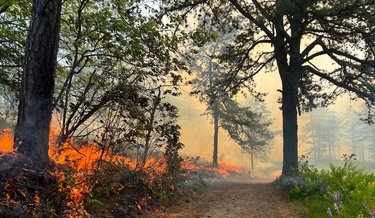Air quality advisory issued for Albany County
ALBANY COUNTY — As part of the Upper Hudson Valley, Albany County was added to the areas where an air quality advisory was issued by the state’s commissioners of environmental conservation and of health on Tuesday and then again on Wednesday.
More than 100 wildfires burning in Quebec are causing hazy conditions across much of the state, said a Tuesday afternoon release from the governor’s office.
“When many New Yorkers walked outside today, the hazy skies caused by wildfire smoke were hard to miss,” said Governor Kathy Hochul in the release.
On Wednesday, Hochul recommended that schools cancel outdoor activities.
“According to the most recent forecast, much of the state outside of the North Country is expected to be in an air quality index of unhealthy to very unhealthy today,” Hochul said in a Wednesday morning release. “Additionally, my administration has been in contact with the cities of Syracuse, Rochester and New York. I support their decisions and the decisions of other districts to suspend outdoor school activities and strongly urge those who have not yet done so to follow suit.”
“Given the heightened air pollution levels we are seeing across much of the state, the New York State Department of Health recommends that New Yorkers limit strenuous outdoor activity to reduce the risk of adverse health effects,” said James McDonald, the state’s acting health commissioner, in the Tuesday release.
“People who are especially sensitive to the effects of elevated levels of pollutants, including the very young and those with pre-existing respiratory problems such as heart disease or asthma, should avoid spending time outdoors, if possible,” said McDonald. “Those who experience symptoms or have symptoms that worsen should consider consulting their personal physician.”
Fine particulate matter was expected to exceed an Air Quality Index value of 100 in the areas where advisories were issued; the AQI was created as an easy way to correlate levels of different pollutants to one scale, with a higher AQI value indicating a greater health concern.
Fine particulate matter, a release from the DEC explains, consists of tiny solid particles or liquid droplets in the air that are 2.5 microns or less in diameter, which often come from processes that involve combustion, such as vehicle exhaust, power plants, and fires, or from chemical reactions in the atmosphere.
Exposure can cause short-term health effects such as irritation to the eyes, nose, and throat; coughing; sneezing; runny nose; and shortness of breath. Exposure to elevated levels of fine particulate matter can also worsen medical conditions such as asthma and heart disease. People with heart or breathing problems, and children and the elderly may be particularly sensitive.
When outdoor levels are elevated, going indoors may reduce exposure. If there are significant indoor sources — such as tobacco, candle or incense smoke, or fumes from cooking — levels inside may not be lower than outside. Some ways to reduce exposure are to minimize outdoor and indoor sources and avoid strenuous activities in areas where fine particle concentrations are high.
The June 6 advisory had applied to the Long Island, New York City Metro, Lower Hudson Valley, Adirondacks, Eastern Lake Ontario, and Central New York regions as well as to the Upper Hudson Valley.
For June 7, Western New York was added and the Adirondacks were removed.
Additional information on ozone and PM 2.5 is available on the DEC’s website and on DOH’s website.
DEC advice
The DEC urges New Yorkers to take the following energy saving and pollution-reducing steps:
— Use mass transit instead of driving, as automobile emissions account for about 60 percent of pollution in our cities;
— Conserve fuel and reduce exhaust emissions by combining necessary motor vehicle trips;
— Turn off all lights and electrical appliances in unoccupied areas;
— Use fans to circulate air. If air-conditioning is necessary, set thermostats at 78 degrees;
— Close the blinds and shades to limit heat build-up and to preserve cooled air;
— Limit use of household appliances. If necessary, run the appliances at off-peak hours, after 7 p.m. These would include dishwashers, dryers, pool pumps, and water heaters;
— Set refrigerators and freezers at more efficient temperatures;
— Purchase and install energy-efficient lighting and appliances with the Energy Star label; and
— Reduce or eliminate outdoor burning and attempt to minimize indoor sources of PM 2.5 such as smoking.
— Melissa Hale-Spencer

